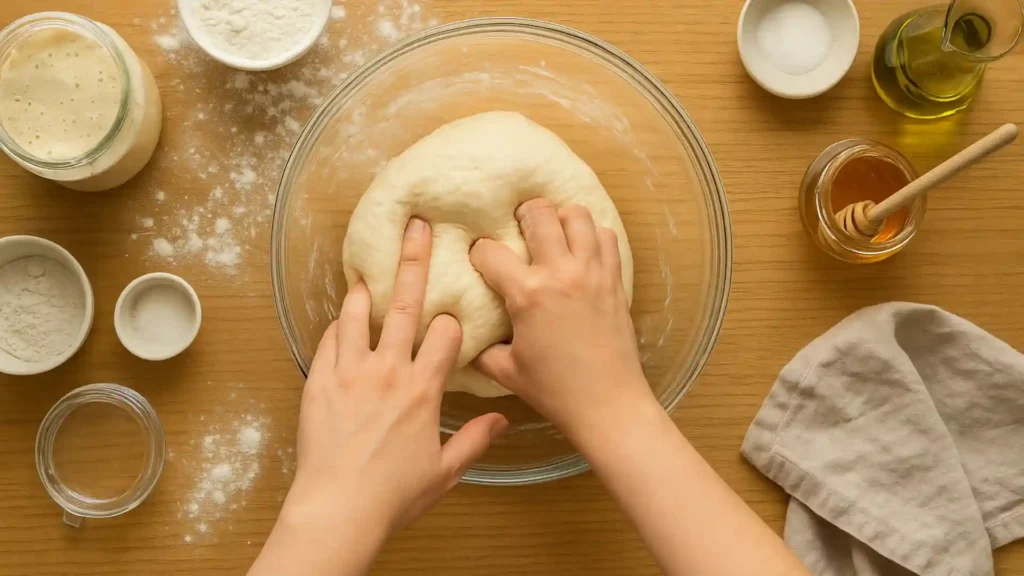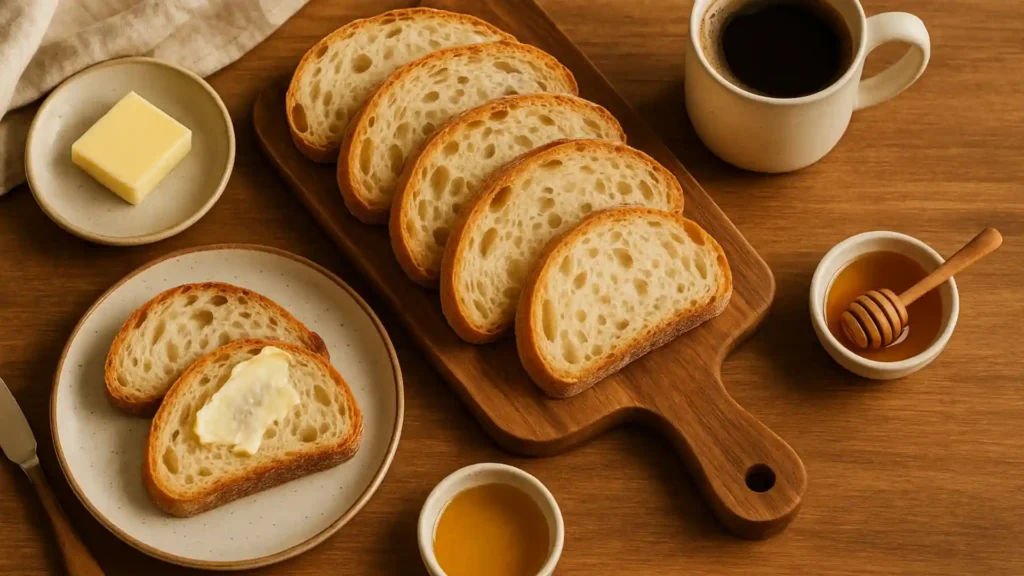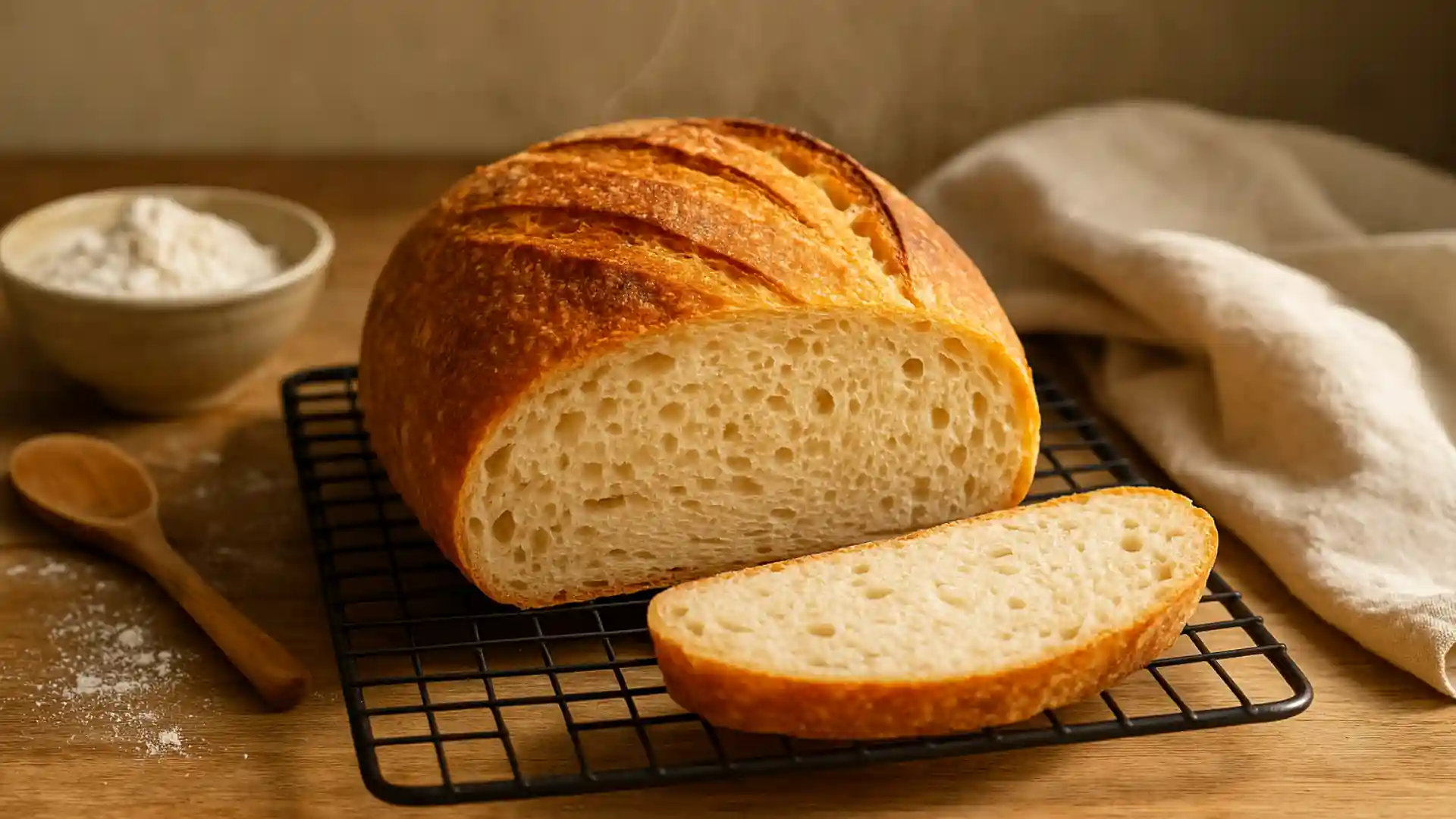There’s something deeply satisfying about turning kitchen leftovers into something warm golden and freshly baked especially with this Sourdough Discard Bread recipe.
This bread has its roots in the rustic kitchens of Europe where bakers refused to waste even a crumb of their precious starter. Over time it’s become a favorite in American kitchens too especially among home bakers who’ve embraced the art of sourdough. People love this recipe because it’s simple quick and forgiving. You get that signature sourdough flavor without waiting all day for fermentation.
I first baked this bread on a chilly Sunday morning when my kitchen smelled faintly of coffee and flour. What started as an experiment to save a bit of discard became a weekend ritual one that fills the house with warmth and the kind of comfort that only homemade bread can bring. Whether you’re new to sourdough or a seasoned baker this recipe is proof that even the leftovers can turn into something worth sharing.
Ingredients for Sourdough Discard Bread
The beauty of this Sourdough Discard Bread recipe is its simplicity. You only need a handful of pantry staples no fancy tools no complicated steps just real ingredients that come together beautifully.
Main Ingredients
- 1 cup sourdough discard about 250 g unfed starter works perfectly
- 2½ cups all-purpose flour 300 g or use bread flour for more chew
- ¾ cup warm water 180 ml around 100°F warm to the touch but not hot
- 1 tsp instant yeast optional helps the bread rise faster
- 1½ tsp fine sea salt enhances the flavor and balances acidity
- 1 tbsp honey or sugar adds a hint of sweetness and color to the crust
- 2 tbsp olive oil or melted butter for a tender crumb and golden top
Healthy or Dietary Substitutions
- Whole wheat version: Replace up to half of the all purpose flour with whole wheat flour for extra fiber and a nutty flavor.
- Vegan option: Swap honey for maple syrup or agave nectar.
- Gluten free version: Use a 1:1 gluten free flour blend and add 1 tsp xanthan gum to help the dough hold together.
- Oil free: Skip the oil and brush the loaf with a little water before baking for a crispier crust.

Tips for Choosing Quality Ingredients
- Use unbleached organic flour whenever possible it contains more natural yeast and better flavor.
- Make sure your sourdough discard is no more than 3 days old and stored in the fridge older discard can add too much sourness.
- Filtered or bottled water is best since chlorine in tap water can slow fermentation.
How to Make Sourdough Discard Bread Step by Step Guide
This Sourdough Discard Bread recipe is perfect when you want fresh homemade bread without the long waiting time of traditional sourdough. It’s simple quick and yields a beautifully soft loaf with a subtle tang.
Step 1 Mix the Dough
In a large mixing bowl whisk together your sourdough discard warm water and honey or sugar until well combined.
Add the flour salt and instant yeast if using. Mix until the dough comes together and no dry spots remain.
Pro Tip: The dough should feel slightly sticky but easy to handle. If it’s too wet sprinkle in 1–2 tablespoons of extra flour.
Step 2 Knead Until Smooth
Transfer the dough to a floured surface and knead it for about 8–10 minutes or use a stand mixer with a dough hook for 5–6 minutes.
You’re looking for a smooth elastic texture that bounces back when gently pressed.
Pro Tip: Don’t over knead a light springy dough bakes up softer and airier.
Step 3 First Rise
Place the dough into a lightly greased bowl cover it with a clean kitchen towel or plastic wrap and let it rest for 1 to 2 hours in a warm spot.
It should nearly double in size.
Pro Tip: If your kitchen is cool place the bowl inside your turned off oven with the light on perfect proofing temperature!
Step 4 Shape the Loaf
Once the dough has risen punch it down gently to release air.
Shape it into a smooth loaf by folding the edges toward the center then rolling it seam side down.
Place it in a greased 9×5 inch loaf pan or shape it free form on a parchment lined baking sheet.
Step 5 Second Rise
Cover the shaped dough and let it rise again for 30–45 minutes or until puffy and slightly domed over the pan.
Pro Tip: To test readiness gently press a fingertip into the dough if it springs back slowly it’s perfect for baking.
Step 6 Bake the Bread
Preheat your oven to 400°F 200°C.
Bake the loaf for 30–35 minutes or until golden brown and the top sounds hollow when tapped.
If you want a shiny crust brush the top with melted butter right after baking. For a rustic crust lightly mist the loaf with water before baking to create steam.
Step 7 Cool Before Slicing
Remove the bread from the pan and let it cool on a wire rack for at least 20–30 minutes before slicing.
This helps the crumb set and prevents it from becoming gummy.

Pro Tip: The aroma at this stage is incredible resist slicing too early for the best texture!
Tips & Variations for Your Sourdough Discard Bread
One of the best things about this Sourdough Discard Bread recipe is how flexible it is. Once you master the base version you can easily tweak it to match your taste dietary needs or even your mood.
1. Flavor Variations
Add personality and flair to your loaf with these delicious twists:
- Garlic Herb Bread: Mix in 1 teaspoon of garlic powder and 1 tablespoon of dried herbs like rosemary thyme or oregano.
- Honey Oat Bread: Sprinkle rolled oats on top before baking and replace sugar with honey for a wholesome slightly sweet flavor.
- Cheese Lover’s Twist: Fold in ½ cup of shredded cheddar parmesan or mozzarella before shaping your loaf.
- Cinnamon Raisin Bread: Add 1 teaspoon cinnamon ¼ cup brown sugar and ⅓ cup raisins for a sweet breakfast version.
Pro Tip: Don’t overload your dough with heavy mix ins ½ cup total is usually perfect for even baking.
2. Dietary Adjustments
- Vegan Friendly Version: Use olive oil instead of butter and maple syrup instead of honey.
- Gluten Free Option: Substitute with a 1:1 gluten free flour blend and add 1 teaspoon xanthan gum for structure.
- Whole Grain Boost: Swap half of the all purpose flour with whole wheat or spelt flour for a heartier flavor and extra nutrition.
Remember: every flour absorbs water differently. Adjust your hydration slightly as you experiment.
3. Texture & Crust Tips
- For a crispy crust place a small oven safe bowl of water on the lower rack during baking the steam helps create that perfect crackle.
- For a soft crust brush the loaf with melted butter right after baking and cover it loosely with a towel while it cools.
- Want more rise Add 1 teaspoon of yeast even if your discard is active it gives a lighter texture without losing that sourdough flavor.
4. Serving Suggestions
This bread is as versatile as it is delicious:
- Slice and toast it for avocado toast or morning sandwiches.
- Serve it warm with soups, stews or chili.
- Use leftovers to make croutons or bread pudding.
- Spread with butter and sea salt for the ultimate comfort bite.
Nutritional Information Per Serving
While Sourdough Discard Bread feels like pure comfort food it’s surprisingly balanced especially when made with wholesome flour and natural starter. Here’s a general breakdown for one average slice based on a 12 slice loaf
| Nutrient | Amount Approx. | Details |
|---|---|---|
| Calories | 180–200 kcal | Great energy source for breakfast or lunch. |
| Fat | 3–4 g | Mostly healthy fats from olive oil or butter. |
| Protein | 5–6 g | Helps keep you full and supports muscle repair. |
| Carbohydrates | 36–38 g | Complex carbs for steady energy release. |
| Fiber | 2–3 g | Higher if using whole wheat or oats. |
| Sugar | 2–3 g | Naturally mild from honey or added sugar. |
| Sodium | 200 mg | Controlled by the amount of salt used. |
Health Benefits of Sourdough Discard Bread
- Easier to Digest: Thanks to the mild fermentation in the discard the bread is often gentler on the stomach than commercial yeast breads.
- Rich in Nutrients: Whole grain flours increase fiber and B vitamins.
- Supports Gut Health: Naturally occurring lactic acid bacteria from the starter can support healthy digestion.
- Balanced Energy: The combination of protein complex carbs and a touch of natural fat helps maintain stable energy levels throughout the day.
Pro Tip: If you’re health conscious try substituting part of the flour with spelt or whole wheat to increase fiber without losing softness.
Common Problems & How to Fix Them
Even with an easy Sourdough Discard Bread recipe a few things can go wrong especially if you’re new to baking. Don’t worry Every issue has a simple fix and even imperfect loaves are still delicious.
1. The Bread Didn’t Rise Enough
Possible Causes:
- The sourdough discard was too old or inactive.
- Your kitchen was too cold during proofing.
- You skipped the yeast but didn’t allow enough time for fermentation.
Fix It:
Warm your dough’s resting spot around 75°F/24°C and give it an extra 30–60 minutes to rise. Next time use fresher discard 1–3 days old or add 1 teaspoon of instant yeast for a boost.
Pro Tip: Always cover the dough with a damp towel or plastic wrap to prevent it from drying out.
2. The Crust Is Too Hard
Possible Causes:
- The oven temperature was too high.
- The bread baked for too long or without steam.
Fix It:
Try baking at 375°F 190°C next time and place a small pan of hot water on the bottom rack during baking to add moisture. Brush the top with melted butter as soon as it comes out of the oven for a softer crust.
3. The Bread Is Dense or Gummy Inside
Possible Causes:
- The dough wasn’t kneaded enough.
- The bread was sliced before it cooled completely.
- There was too much moisture or not enough rise time.
Fix It:
Knead longer until the dough feels elastic and always let the bread cool at least 30 minutes before slicing. If your kitchen is cool extend the proofing time by 20–30 minutes.
Reminder: Cutting too early traps steam inside making the crumb sticky instead of fluffy.
4. The Bread Tastes Too Sour
Possible Causes:
- Your discard was old or overly fermented.
- You left the dough to rise too long.
Fix It:
Use discard that’s no more than 3 days old and shorten fermentation time slightly. For a milder taste mix the discard with a pinch of sugar or honey before adding the flour.
5. The Top Cracked During Baking
Possible Causes:
- The dough surface dried out.
- The oven was too hot too soon.
Fix It:
Cover your dough during proofing and preheat your oven thoroughly. You can also lightly score the top with a sharp knife before baking to control where it expands.
Frequently Asked Questions FAQ
1. Can I use sourdough discard straight from the fridge?
Yes You can use cold discard directly from the refrigerator. Just let it sit at room temperature for about 30 minutes before mixing so it blends more easily with the other ingredients.
Tip: Fresher discard 1–3 days old gives the best flavor balance slightly tangy but not too sour.
2. Do I need to add yeast to this recipe?
Not necessarily. If your discard is very active, you can skip the yeast and simply let the dough rise longer about 3–4 hours. However if you want a quicker more reliable rise 1 teaspoon of instant yeast will give your bread that perfect lift.
3. How do I make this recipe vegan?
This recipe is already easy to adapt!
- Replace honey with maple syrup or agave nectar.
- Use olive oil instead of butter.
That’s it your vegan sourdough discard bread will still be soft flavorful and golden.
4. How long does sourdough discard bread stay fresh?
At room temperature your loaf will stay fresh for about 2 days if stored in an airtight container or wrapped in a clean kitchen towel. For longer storage:
- Refrigerate: Up to 5 days.
- Freeze: Slice the loaf wrap in plastic or foil and freeze for up to 3 months.
Pro Tip: Toast frozen slices directly they crisp up beautifully!
5. Can I use whole wheat or gluten free flour instead of all purpose?
Yes For whole wheat swap half of the flour for a heartier nuttier flavor.
For gluten free use a 1:1 gluten free blend and add 1 tsp xanthan gum for better structure. Expect a denser loaf, but still soft and flavorful.
6. My discard smells really sour is it still safe to use?
A slightly sour tangy smell is normal. If it smells like vinegar or mild yogurt it’s fine. But if you notice a strong cheese or rotten odor dark mold or pinkish streaks it’s best to discard and start fresh.
Conclusion + Call to Action
And there you have it a loaf that proves nothing in your kitchen has to go to waste. This Sourdough Discard Bread recipe is more than just a way to use up leftovers it’s an invitation to create something comforting homemade and full of flavor. Each slice tells the story of patience warmth and that unmistakable sourdough tang that makes your home smell like a bakery.
Once you’ve made it you’ll see why this bread has become a weekend favorite for so many home bakers. It’s soft versatile and perfect for everything from toast and sandwiches to buttery golden slices straight from the oven.
Now it’s your turn bake it taste it and make it your own!
When you try this recipe leave a comment below to share how it turned out your feedback and creative variations inspire others to give it a go, too.
If you loved this recipe explore more sourdough goodness from our kitchen:
- Easy Sourdough Bread Recipe the perfect everyday loaf.
- Easy Gluten-Free Sourdough Bread Recipe for a soft gluten free alternative that doesn’t compromise on flavor.
- Sourdough Starter Recipe your guide to building a strong healthy starter from scratch.
We’d love to hear from you!
Did you add your own twist Maybe garlic cheese or cinnamon Tell us how it turned out in the comments or tag @QuickMorsels on social media with your sourdough creations.
Whether you’re baking to relax reduce waste or rediscover the joy of real bread this recipe is your invitation to slow down and savor every slice.
Happy baking and see you in the next recipe!
